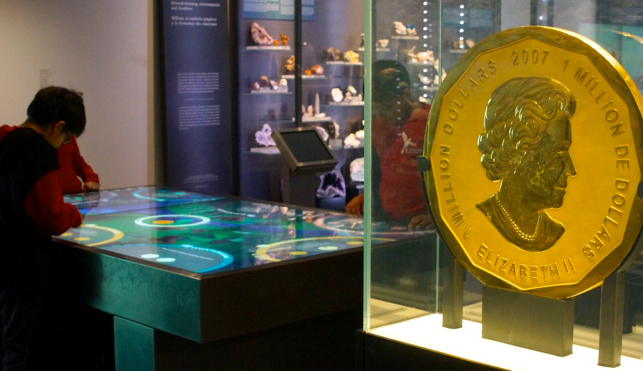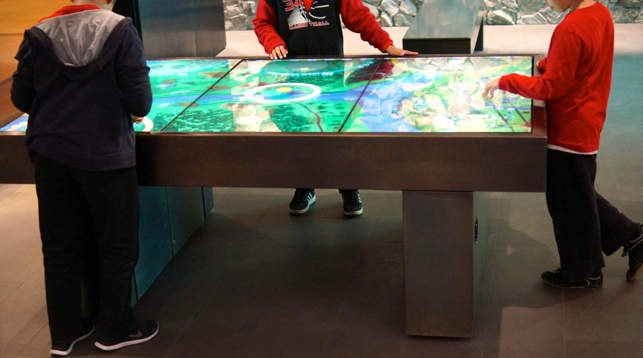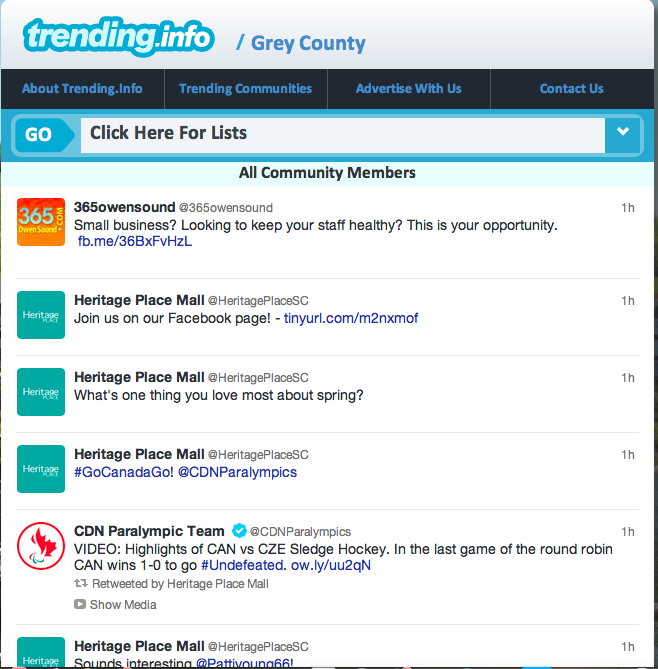This may be less common at academic gatherings, but at events in the technology industry you can now reliably count on the organizers setting up a giant monitor somewhere on site that shows a running feed of all the comments from attendees on Twitter. Usually these are organized by the hashtag that identifies the event. There’s usually little attempt to filter or highlight anything that gets displayed on the screen. It’s as though, after realizing people were not putting away their smartphones and would be providing a running commentary about their experience online, conference producers want to show that they are aware and encouraging of the practice. The monitor, like the buzz of conversation at the networking cocktail reception near the end of a conference, is a way of showing that the whole thing was a big success.
To me, though, Twitter walls at events are a huge missed opportunity, and show how far we still have to go to integrating display technology in a way that’s more effective and sustainable. What gets tweeted during the keynote speeches, plenary sessions and coffee breaks represent an incredible source of data on what resonated with attendees. Instead of capturing and studying it, event producers tend to simply turn off the monitor at the end of the day and rely on people filling out that same paper-based evaluation forms they’ve been using for decades. They fail to recognize that what’s being said on social media is a parallel but distinct event in its own right. It should be a place where experts engage, contribute and provide additional value to what’s being said on stage.
This isn’t just a failing of the conference industry. Instead of a monitor, why aren’t more people implementing software to power actual digital signs which would not be limited to a day or multi-day event but permanently installed in helpful locations within an organization? Examples might be the lobby of a public space where visitors could get a sense of what’s going on inside or tweet questions about what they need upon arrival. Retailers could offer information about products and services right next to a shelf, and curate links to videos, articles and other content that help shoppers get more out of what they’re preparing to buy. There are plenty of startups with good products that could offer some degree of this today, including Tint, SocialWally and TweetBeam, but I suspect there’s also still lots of room to innovate here.
So much of what you see in digital signage is basically a one-way conversation between who owns the sign and those that happen to glance in its direction. There are still untold ways that the silent but never-ending dialogue taking place on social channels could be harnessed, curated and amplified to completely rethink the user experience of being in a particular location. It’s time to pay more attention to the enormous panel discussion that happens long before — and long after — any kind of isolated conference or event takes place.
]]>The Project: “I am trying to build better technology for people working and socializing in a face-to-face environment. Primarily, I am interested in supporting small groups of collaborators or friends and families getting together. I focus on large screen technology, such as interactive tables and interactive walls.” As her online bio states: Her particular area of specialization is in the development of digital tabletop computer technology for supporting various face-to-face collaborative and social endeavors, including both “serious” pursuits such as military command and control and emergency response, and more “playful” pursuits such as board gaming. As a strong advocate of the potential of digital tabletop technology to support collaboration – yes even (way) before the invention of the Microsoft Surface (now PixelSense) – she is heavily involved in the interactive tabletop and surface international research and development community, as well as in the more broad communities of human-computer interaction (HCI) and computer-supported cooperative work (CSCW).
The Progress: From the fringes of technology 14 years ago to the having a seat at the (digital) table, Scott has proven that her passion for an idea before its time has paid off – interactive large tabletop technology is becoming an affordable reality for the masses. Within a couple of years, living rooms will boast a 4k television, table tops will become digital game boards and colleagues will digitally swap information around a table. The future has arrived, says Scott.
What seems so strange is that many of us already assumed this technology was here – from the Hunger Games’ large-scale control room and James Bond’s multi-touch table in Quantum of Solace – to the ubiquitous iPad that even toddlers use. But, according to Scott, while her and her colleagues were inventing the software, the actual physical hardware is just now being invented. It’s not as easy as making an iPad bigger, as Scott points out that iPad technology is not scalable to a bigger surface. So Scott is focused on technology that is designed for much large surfaces. And now the hardware side is finally catching up, especially in Europe, so we can look forward to using digital tabletops at the office and in the home within a few short years, says Scott.
The Prospects: The future is golden for this type of research. Scott says with Microsoft’s recent purchase of Perceptive Pixel, they’ve become a major player in this technology area again, driving the need for the leading-edge software that Scott and her colleagues has been developing. In Canada, Smart Technologies is making strides in the hardware, but, according to Scott, Europe is where much of the hardware action is happening. This progress means commercializing Scott’s work is the next step. It’s a case of “if you build it, they will come.”
The Passion: Improving collaboration around large digital surfaces is what drives Scott. “I always saw the promise in it, but it was really hard to convince others. But now I can tell people to imagine a really large iPad that people are sitting around collaborating. Suddenly, people can imagine the possibilities, now they can picture what a future workspace will be.” They are finally catching up to Scott’s vision.
]]>
Featuring an 8-panel video wall and a 65” touch-screen display (from NEC) this installation is the first of its kind in Canada. It’s set up to show behind-the-scenes moments and enable fans to purchase exclusive sports memorabilia.
Launched last week, MasterCard teamed up with Maple Leaf Sports & Entertainment to create the Priceless Toronto Zone, allowing fans to interact with video content on the big screen and use their mobile phone to complete the transaction.
The Priceless Toronto Zone is currently set up to entice fans to buy sports memorabilia during Raptors and Leafs games. In a few simple steps, you can browse and purchase from a selection of collectible bobble-heads featuring the likeness of Raptors and Leafs mascots and players.
If you’re a Canadian MasterCard cardholder or MasterPass account holder, you can buy one of these collectible figures for $15.99. All net proceeds are being donated to the MLSE Foundation, which aims to improve the lives of youth by building facilities, giving to sustainable programs and empowering youth through sports and recreation.
Adjacent to the interactive screen is an 8-panel video wall where video content is likely to be streamed. There’s also a kiosk-like area on the other wall that looks like it’s supposed to entice fans to register with Priceless Toronto on one of four iPads secured to the wall at about hip-level. These small screens by comparison appear more like an afterthought to the whole interactive digital experience.
MasterCard has also now outfitted its food-and-beverage concession stands with contactless Tap & Go technology, enabling fans to quickly pay with the tap of their MasterCard to ensure they don’t miss a moment of the action.
All photos by Roger Cullman.
]]>The company recently launched a set of customizable digital signage products for small to medium-sized businesses (SMBs) that can cost little more than a hundred dollars a month and are set up free of charge. Along with the LED hardware, Toshiba is offering assistance with template design and a content “starter kit.” And while Toshiba is a global company, the digital signage products were created out of its Markham, Ont.-based headquarters.
CommerceLab reached out to Alex Mourra, solutions product marketing manager with Toshiba of Canada, to better understand why those commercializing display technology might find a wider market among SMBs.
What was the impetus behind Toshiba of launching its Canadian-designed digital signage technology? Can you speak about market demand among small businesses, especially for HD (e.g., 1080p LED displays)?
There were customers coming to Toshiba with requests for digital signage. They recognized the attractive, HD displays could boost their marketing efforts, customer experience and ultimately sales. However, at the time all we could supply was the hardware not the content management solution. A lot of the existing solutions out there were meant for big businesses and were not easily scalable or affordable for SMB. Danny Lee Yow really spearheaded the project but we saw the need, we had the resources to develop a digital signage solution and we had full corporate support to deliver.
Can you describe the level of control businesses will have over their content? In other words, a quick rundown of how it works?
It uses a cloud-based Toshiba Content Management System which can support a wide variety of content and file formats including video, images, RSS feeds, embedded YouTube videos and web pages, flash and more. Toshiba will assist with the initial design and content customization, but once everything is up and running users have full, centralized control of their content and can update it anytime, as often as they want via a web browser and internet access. If the user has multiple displays set up they can push out updated content to all screens at the same time, from any location using their laptop.
Can you explain the decision to incorporate remote access via the cloud? Was this another thing you identified as a market demand among small businesses?
Cloud-based computing has largely gained in popularity over the last few years and we know more and more small-to-medium businesses are taking advantage of the flexibility it offers. It allows them to do more with less since all you need is an internet connection and browser, and it offers more mobility in the age of portable computing devices. Manageability and security concerns may present a challenge for larger companies considering cloud computing, (but) SMBs have been quick to jump on the trend, from our experience. And in the case of our Display Solution, the IT infrastructure resides entirely on Toshiba’s side so the only thing clients need to worry about is content which we can also help with.
In terms of tech support, can you distinguish between the customer’s remote monitoring and your own remote monitoring for technical support purposes? Are they linked somehow?
Each package includes 24/7 Canadian live agent technical support and 24/7 remote monitoring service which clients can access by calling our 1-800 line anytime. Remote monitoring means that we are constantly monitoring to make sure the system is up and running. If it’s not, we will try and fix the problem remotely or call the customer to help them with the issue. This is especially helpful if the customer has multiple displays. The owner may not always be on the premises to watch the displays so it’s good to have another set of eyes on them. The package also includes an on-site exchange warranty for the displays and media box so businesses don’t need to worry about any disruptions to their service. If there is a hardware issue, we will replace it on the spot instead of going back and forth on repairs.
]]>He says shoppers’ current experience in retail environments is lackluster at best. He’s developed an interactive digital retail display called POET, or Point of Experience Terminal, which is designed to give users a rich, multimedia-based experience with the product or subject they’re showcasing. POET was originally profiled in CommerceLab in July of last year.
POET was installed in a pilot project at the City of Waterloo Museum for a recent exhibit celebrating 100 years of Seagram’s Whiskey. Neill spoke with CommerceLab about lessons learned in the pilot and why he thinks there’s a massive opportunity in retail for this type of technology.
Tell us how the POET displays were used to enhance the public’s experience at the Seagram’s Exhibit.
In October we did a project with City of Waterloo Museum at Conestoga Mall – 100 years of Seagram’s VO Whiskey. We put together an interactive installation where users come up and scan objects related to the distillation process – wheat in a jar, a particular bottle and that sort of thing – and when they scan that, the receive all kinds of information.
How did the project get started?
Last year in May we had an open house at the Felt Lab. We had a simulation of POET going on to demonstrate the possibilities of what we were trying to do. The City of waterloo representatives attended and we talked to them about the museum. This was the first really public installation and it was nice to have an actual physical installation that people in the public were interacting with. The city really let us test things out.
Describe the interface and display used at the Museum.
We were experimenting so we had to work with what the museum had on hand. Typically, the user interface is touch-screen, but the museum didn’t have the budget for that because they can get pretty expensive. To compensate, we integrated Leap Motion, a gesture based controller. At $80, it’s a relatively inexpensive solution, and allows users gestures to translate into actions on the screen. We integrated this hardware to simulate the touch screen experience.
Your original focus with POET was on the retail market. As your research continues, what are the biggest challenges you see in penetrating that market?
Our original focus was to go to retailers such as Sportcheck, for example, and install a a shoe wall – display for running shoes – with information served up on all the various types of running shoes. Sportcheck, in turn, would go to Nike, Adidas, Reebok and others to get information and feed it back to us. It seemed like a good plan, but who pays for this – the manufacturers or the retailer? The technology isn’t the question; it’s the politics around it.
We shifted our focus and instead will target the manufacturers directly. They already have a lot of content on their existing Web sites – videos, product images and useful information. Give it to us and we will make it look awesome.
Beyond retail and gallery types of spaces, have you had any interest from other industries?
We’ve been thinking of restaurants – the form factor doesn’t matter. You just need to scan something and learn about it, such as items on the menu. We’ve also been brainstorming about airports and how the technology could be used at gates.
We will be doing a lot more pilots in the near future to better understand how users use the technology. We will then take that data to potential clients and say this is the kind of thing we did. It raised sales by X and people used it X percentage of the time. And these are the benefits it can bring.
What inspired you to develop POET?
I worked in retail for seven years at Tim Horton’s and Starbucks. I want to change how people perceive retail environments. A lot of the time retail is a lackluster experience, hindered by not finding information or having to rely on someone. I want to change that and hand power back to the customer so they can make an informed decision.
What has been your greatest lesson as an entrepreneur?
It has become more apparent – as I dive deeper into this culture – that being an entrepreneur is half about what you’re selling and half about the relationships. A lot of companies have amazing developers, but if they don’t have people who can relate to customers and their business issues it’s going to fail.
How did being profiled on CommerceLab help POET’s entry to the market?
Especially since we are a student-run startup, exposure on the site was helpful to show people that we are taking things seriously. For example, many early-stage startups tell people that “we are having conversations with company X or Y,” when really they have somewhat exaggerated their relationship with that party. For us, it was useful to have a reputable source recognize the relationship the Felt lab/REAP has with industry experts, and consequently what POET has in terms of professional support. It allows us to tell people that what we’re doing isn’t arbitrary; we’re actually doing our homework and utilizing our resources.
The gallery, located in the ROM’s Teck Suite of Galleries: Earth’s Treasures (Level 2), is an interactive 600-square-foot space with multi-touch, animated displays and multi-media presentations.
Just inside the gallery you’ll find the world’s largest gold coin, a 100 kg $1M gold coin enclosed in a glass display case. While this specimen is untouchable, the interactive Game Table behind it is meant to be touched.
Comprised of three 55″ screens (each measuring 48″ x 27″) the Game Table stands about waist-high, enabling easy hands-on access to the display. Users are encouraged to drag-and-drop icons around the screen by tapping coloured circles and swiping their fingers along the backlit surface. Each gesture they make results in a measurable outcome in the mining process shown on the screens.
Users learn about the challenge of modern mining and get to manage the delicate balance between production and sustainability. In essence, they’re finding out how similar real-world decisions would impact the future of mining — while having fun interacting with this display. Think of it kind of like The Sims game in microcosm. There’s also an iOS app called ROMining that’s works much the same way on mobile devices.
Adjacent to the Game Table is a four-panel Touch Wall that features images, illustrations and text that let visitors explore the extent of our reliance upon the products of mining, encouraging them to make responsible decisions in consuming valuable resources.
“This project took over two years from conception to launch and a year to develop and implement the two interactive installations in the Gallery,” says Courtney Murfin from the ROM’s Interpretive Planning department.
“Both interactives were conceptualized in house by the ROM, and content was also developed by the ROM. We undertook two rounds of scheduled/facilitated user testing over two months, followed by three months of further development updates and testing.”
The hardware used for the screens are MultiTaction screens from MultiTouch Ltd.. Independent Toronto companies developed the systems for both the Touch Wall (Meld Media) and the Game Table (Aesthetec Studio).
The Game Table and the Touch Wall are now a permanent part of the Barrick Gold Corporation Gallery of Mining, providing the most advanced, hands-on, user-driven visitor experiences at the ROM.
]]>
That’s when Huitema, who has worked in the web development and tech industry for more than 20 years, decided to create a solution for himself. He began by creating a list of people and businesses in Stratford who tweeted useful information about community events, and showcased all of their tweets on a single web page.
Soon enough people began to take notice. “All my friends were going ‘how’d you hear about that’ or ‘how’d you know about this?’” he said.
Though it began as a hobby and a personal tool, Huitema soon saw a demand for this information in his community. He moved into the Stratford Accelerator Centre approximately eight months ago, developing his website, Trending.info, during early mornings, lunch breaks, evenings and weekends while continuing his day job as a system administrator for the government of Perth County.
Today, Trending.Info is a publicly available service that amalgamates community-based information from various online sources. Its pages not only cover events in Stratford, but also cities as far-reaching as Dubai and Beirut, post-secondary institutions from Western University to Michigan State, and sports communities ranging from Premier League Soccer to UFC.
“It sort of creates a digital sidewalk of what’s going on in a community in real time,” said Huitema, adding that many of his users prefer not to have social media accounts, but still need a reliable source for local information. “It embraces what’s going on on social media for the non-techie people.”
Though Huitema continues to work at his day job, the company has seen tremendous growth in its first few months. Trending.info now provides information on 51 different communities, including 18 Canadian cities and towns. Huitema has plans to bring Trending.info into 17 to 20 new locations in Canada this year, as well as at least one community in all 50 states, and is currently working on a large deal in the Caribbean.
Huitema’s secret is finding community managers in each location who are knowledgeable and passionate about their beat. He uses either a licensing or franchising model that allows community managers to sell their own ads, sending a small cut back to Stratford. “We’re throwing around a number of models right now,” he said.
Perhaps the biggest testament to the usefulness of trending.info came when Famme and co., a local accounting firm which replaced the community posters hanging in its window with a large LCD screen, displaying the Stratford feed.
“As people walk by they’ll see the Trending.info Stratford page, which has been customized for (Famme and Co.) so that only the people they want followed are displayed,” he said. “People stop and watch to see what’s going on in town on their way downtown.”
Having recently hired four staff members, Huitema is planning a major overhaul of the site.
“This has been pulled together by a guy and a half over the last eight months, and now it’s expanded to five people who are passionate and they see the vision,” he said. “We’re going to do our best to make it what we hope and know it should be.”
]]>
Today, he’s the director of McGill’s Shared Reality Lab. One of the many research jobs he’s been involved in is an international effort known as the Natural Interactive Walking project, which uses a range of high-tech gadgets: audio, visual and, most importantly, a “smart” floor that can simulate walking on different surfaces.
The project: At the lab the NIW project is focused on people’s feet. The smart floor allows users’ moving feet to sense some startling things, from walking on “sand” to “something like ice,” Cooperstock says.
The basic aim of the project is to study the full range of tactile experiences people get from walking on different surfaces. This will, hopefully, lead to new technologies, both hardware and software, that will make the virtual ground seem very real, he adds.
His team at the lab will strive to innovate more, making these sensations seem more real by testing new ways of removing the many technological barriers to achieve the perfect system.
The progress: One of these further scientific explorations includes “developing dynamic levels of friction so that the user doesn’t experience a constant kind of ‘slip factor,’” says Cooperstock. As another effort, the lab is working on rendering vibrations to the feet that simulates what happens when they water, before the subject physically makes contact with the ground.
The vibrations are created through a tile surface, but if simulation of water contact is needed, it creates a ‘conflict’,” he says. “It’s telling you two competing things.”
“What we want to do is avoid that kind of perceptual conflict and render something that is far more consistent.”
Cooperstock says he hopes to overcome such problems by developing new hardware and software technology that can better “render or simulate the experiences of walking on various ground surfaces.”
The prospects: Cooperstock is confident that the lab’s research will have commercial appeal. The entertainment value alone could be enough to make that happen, he says. For example, the lab will bring in users on a given day and ask them if they want to feel the virtual sensation of walking on snow.
“That’s pretty cool,” he says, adding that he enjoys seeing many people trying the lab’s frozen pond demo “and watching their reactions when the ice ‘cracks’.”
It could also have a plethora of real-life applications in more serious areas, including the medical field. It’s not hard to imagine hospitals treating many kinds of walking problems in a safe and controlled environment in the future.
The passion: What really drives Cooperstock to do this kind of work is the “highly multi-disciplinary” aspect of the research in projects like the NIW.
Many academics from around the world are collaborating and it’s bringing them all closer together. He says this is what keeps him excited and engaged at the lab. The work it’s doing “spans the boundaries of mechanical engineering, computer science, psychology, electrical engineering.”
Combined research in these multiple fields hasn’t been possible in the past, Cooperstock adds. However, IT has opened up new possibilities to do so.
The big motivator for him, as well as his fellow academics, is “the ability to make significant advances in an area that is far removed from one’s own domain of expertise.”
Ultimately, his passion for collaborative research has led to a desire to make a difference in the world. As Cooperstock puts it, “my lab tends to get involved in too many projects for the simple reason that we can’t bear the thought of not being involved in them, especially when the associated applications present opportunities to improve people’s lives.”
]]>
“You can experience all the safety functions in a safe simulator experience and get first-hand experience,” Andreas Gottschol, an engineer with Mercedes-Benz in its Active Safety department explained as he described the driving simulator. “It shows off all the safety functions in the S-class (as well as the E- and C-class) vehicles.”
There are six screens in front of the car and 11 graphic simulation channels. Behind the scenes is a network of 12 powerful computers. And there is a compiler in the trunk telling what the simulation offers is real.
“Technology like this took one year of development time,” says Gottschol. “This is the 4th generation of simulators now.”
The Mercedes Driver Simulation was first introduced at a world press event in Toronto, says Haab. It was also shown in the Frankfurt Auto Show in September 2013 and there are plans to show it off in Stuttgart and Washington.
“From an interactive experience, you keep it a lot more in your mind than just reading about it. Or compared to a regular test drive,” adds Jochen Haab, another Mercedes engineer.
The main audience so far has been the media and potential customers at the big auto shows. But the intention is to eventually take large driver simulation displays like this on the road to large events in dealerships, providing customers with a more immersive experience without the potential dangers of doing so on a test drive scenario.
]]>
As online consumer activity continues to grow, however, retailers are increasingly challenged with bolstering the brick-and-mortar experience to drive in-store traffic and sales. To help combat this, retailers are starting to integrate technology directly onto the retail floor to create a more meaningful shopping environment.
About a year ago, for example, Samsung Canada partnered with Sport Chek to support the launch of its first retail lab concept store in downtown Toronto. Samsung Canada supported the project by providing 140 digital screens and 32 Galaxy 10.1 tablets, enabling the brand to engage consumers at an entirely new level. Samsung’s technology allowed Sport Chek to customize content for its customers and facilitate greater customer interaction with its merchandise. The goal here, obviously, is to improve the overall experience and drive business results. The clip below shows how it’s working.
Sport Chek’s unique retail lab experience is a prime example of a major Canadian merchant embracing the future and anticipating the customer’s appetite for digital integration. Sport Chek is providing a relevant framework for connecting with consumers and building brand affinity with its digitally engaged audience. This is a framework that can be applied in multiple industries across Canada, and Samsung is excited to be at the forefront of this movement, providing its technology to enhance the customer decision journey.
]]>


















